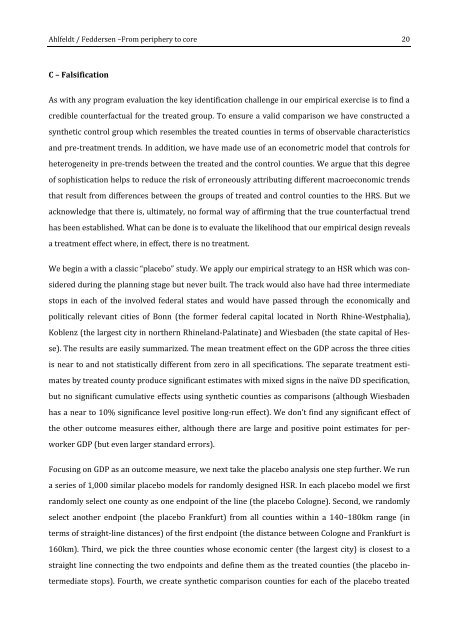sercdp0172
sercdp0172
sercdp0172
You also want an ePaper? Increase the reach of your titles
YUMPU automatically turns print PDFs into web optimized ePapers that Google loves.
Ahlfeldt / Feddersen –From periphery to core 20C – FalsificationAs with any program evaluation the key identification challenge in our empirical exercise is to find acredible counterfactual for the treated group. To ensure a valid comparison we have constructed asynthetic control group which resembles the treated counties in terms of observable characteristicsand pre-treatment trends. In addition, we have made use of an econometric model that controls forheterogeneity in pre-trends between the treated and the control counties. We argue that this degreeof sophistication helps to reduce the risk of erroneously attributing different macroeconomic trendsthat result from differences between the groups of treated and control counties to the HRS. But weacknowledge that there is, ultimately, no formal way of affirming that the true counterfactual trendhas been established. What can be done is to evaluate the likelihood that our empirical design revealsa treatment effect where, in effect, there is no treatment.We begin a with a classic “placebo” study. We apply our empirical strategy to an HSR which was consideredduring the planning stage but never built. The track would also have had three intermediatestops in each of the involved federal states and would have passed through the economically andpolitically relevant cities of Bonn (the former federal capital located in North Rhine-Westphalia),Koblenz (the largest city in northern Rhineland-Palatinate) and Wiesbaden (the state capital of Hesse).The results are easily summarized. The mean treatment effect on the GDP across the three citiesis near to and not statistically different from zero in all specifications. The separate treatment estimatesby treated county produce significant estimates with mixed signs in the naïve DD specification,but no significant cumulative effects using synthetic counties as comparisons (although Wiesbadenhas a near to 10% significance level positive long-run effect). We don’t find any significant effect ofthe other outcome measures either, although there are large and positive point estimates for perworkerGDP (but even larger standard errors).Focusing on GDP as an outcome measure, we next take the placebo analysis one step further. We runa series of 1,000 similar placebo models for randomly designed HSR. In each placebo model we firstrandomly select one county as one endpoint of the line (the placebo Cologne). Second, we randomlyselect another endpoint (the placebo Frankfurt) from all counties within a 140–180km range (interms of straight-line distances) of the first endpoint (the distance between Cologne and Frankfurt is160km). Third, we pick the three counties whose economic center (the largest city) is closest to astraight line connecting the two endpoints and define them as the treated counties (the placebo intermediatestops). Fourth, we create synthetic comparison counties for each of the placebo treated


